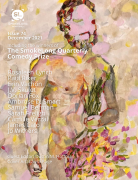In the fall of his ninth-grade year, just months after his father’s execution, Lawrence Eberts and his mother moved to the small town of Rothsburg, Nebraska, and Lawrence became a devout conspiracy enthusiast. His entire demeanor had changed—the quiet kid who used to sit subdued in the back of the classroom was gone. Now he’d blab on and on about how Kurt Cobain didn’t kill himself, how 9/11 was planned by the U.S. government, how Lee Harvey Oswald not only didn’t act alone but was completely innocent.
It was this last one that particularly intrigued him. By November, an intricate web of photos and maps connected by thumbtacked threads of string covered his bedroom walls, implicating everyone from the CIA to the Roman Catholic Church in Kennedy’s murder. He was determined to get to the bottom of it—to discover the real truth, whatever that was.
There was a bit of truth to all of it, though—that was the problem. Cuban vigilantes could have killed Kennedy. The CIA could have killed him and framed Cuban vigilantes to galvanize the U.S. against communism. Perhaps Jack Ruby had murdered him and let Oswald take the fall, and then Ruby had panicked and killed Oswald before he could snitch to the authorities. Or maybe the Vatican, painfully aware of John Kennedy’s status as the first Roman Catholic president, had strategically ended his legacy on the upswing, before he could tarnish the Church’s name with his numerous extramarital affairs—hell, Lawrence wasn’t totally convinced the Pope himself hadn’t been standing at that hotel window, gun at the ready, or behind that grassy knoll.
His new classmates latched onto this unique personality quirk almost immediately. Before he could become “the new kid,” or “the one mixed-race kid in the entire town of Rothsburg,” or “the kid whose father was lethally injected,” Lawrence had already become “the conspiracy kid.” When his American history teacher, a bald, five-foot four-inch ex-military guy named Mr. Babson—120 pounds of pure muscle—began lecturing the class about the moon landing, one of Lawrence’s peers quipped, “Eberts is going to say it never happened.”
“I don’t believe in that one,” Lawrence said quietly, but his words were drowned out by the class’s laughter. Even Mr. Babson let out a hearty, castrato chuckle.
And then there was the final semester paper he submitted for that same class—“A Defense of Scapegoat Lee Harvey Oswald.” By that point, Mr. Babson had clearly seen enough. He scheduled an after-school meeting with Lawrence and his mother.
“It’s been a rough few months for him,” his mom explained, smoothing out her skirt. “For both of us, really.”
“I’m sorry,” Mr. Babson replied. His smile was sympathetic but didn’t quite reach his eyes.
They both turned to Lawrence, as if expecting him to chime in that it was hard—really hard—and that he didn’t really believe any of that stuff about Oswald or JFK or the CIA and was just processing his trauma in the only way he knew how, or something like that.
“There’s no way those bullets both came from the same man,” Lawrence said at last, feeling the weight of their eyes on him. “Watch the video. They come from two completely different directions.”
#
“I want to do a simulation,” he told his mother as soon as they pulled into their driveway. “You be Kennedy; I’ll be the killer.”
“Don’t you think it’s time you…got over this conspiracy stuff?” his mom replied uneasily, putting the car into park. Her expression in the rearview mirror betrayed concern—perhaps even worry. “It’s affecting your schoolwork.”
“You think I’m crazy.” Lawrence furrowed his brow. “I’m not crazy.”
“I didn’t say you were.”
“But you thought it, didn’t you?”
When Lawrence was in the sixth grade, an armed robbery had taken place at the local convenience store during his father’s closing shift. The perp had murdered two customers in cold blood and left the gun on the counter, where Lawrence’s dad had stood, rooted to the spot, an easy target for the cops.
He hadn’t done it, and Lawrence knew he hadn’t done it, because he’d told Lawrence as much, and Lawrence believed him. Still, his father had looked the part, so he’d been charged with the crime and sentenced to death row.
“It won’t take more than five minutes,” Lawrence insisted.
His mother hesitated for a moment. “Okay.”
So Lawrence gleefully rushed up to his bedroom, not bothering to remove his sneakers, tracking half-melted snow all through the house, and grabbed the Nerf gun his father had bought him for his ninth birthday—one with a rotating barrel that could hold up to six foam bullets. Lawrence remembered chasing his dad around the house with it, trying to nail him on the back of the head. Whenever he’d grazed his father’s shoulder or hit his arm, his dad had chided, “Non-fatality!” and kept running.
Now Lawrence stood at his bedroom window, gun in hand, pointing it toward his mother in the driveway below.
He often pictured Oswald sitting in that cramped prison cell, an innocent man, completely oblivious to the fact that his life would be cut short before he got the chance to speak the truth. And he pictured his father on death row, painfully and perpetually aware of the exact time, place, and methodology by which he would die, having spoken his truth many times but never been heard out. Lawrence thought about them both often, and he wondered which one he’d rather be.
His mom stood in the driveway, crouched down on a mock convertible seat. Pop. Lawrence fired a foam bullet. It soared over her head, missing her completely and lodging itself in a nearby snow bank.
His heart pumping, he rushed downstairs. He crouched behind a bush, his mother inching forward in slow motion, still seated on her imaginary leather cushion.
“Non-fatality,” Lawrence muttered, but this time would be different.
He fired from the grassy knoll.



 The core workshop of SmokeLong Fitness is all in writing, so you can take part from anywhere at anytime. We are excited about creating a supportive, consistent and structured environment for flash writers to work on their craft in a community. We are thrilled and proud to say that our workshop participants have won, placed, or been listed in every major flash competition. Community works.
The core workshop of SmokeLong Fitness is all in writing, so you can take part from anywhere at anytime. We are excited about creating a supportive, consistent and structured environment for flash writers to work on their craft in a community. We are thrilled and proud to say that our workshop participants have won, placed, or been listed in every major flash competition. Community works.